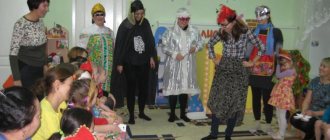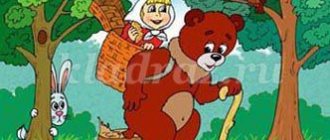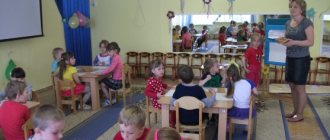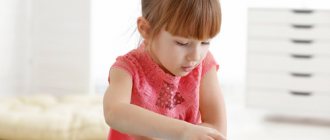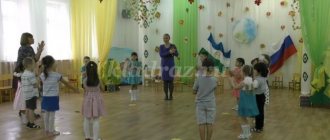TOPIC: Integrated GCD based on the fairy tale “The Three Bears”
Transcript
1 Summary of direct educational activities in the educational field “COGNITIVE DEVELOPMENT” -Educational area: cognitive Conducted by: teacher of the highest category Korobitsyna Rita Abramovna, teacher Ilyina Irina Alekseevna -Age group: junior TOPIC: Integrated GCD based on the fairy tale “The Three Bears” -Integration of educational areas: artistically - aesthetic and physical development - Program objectives: - cognitive development: 1) develop children's interest, curiosity, imagination; 2) teach children to recognize geometric shapes and classify objects; 3) cultivate in children a love of fairy tales and oral folk art. — artistic and aesthetic development: 1) to cultivate in children a love of folk tales; 2) use non-traditional drawing of “animal faces” on stones in teaching children using the poking method and cotton swabs; 3) develop creativity, imagination and sense of color. — physical development: 1) teach children to understand and apply the rules of outdoor play; 2) develop movement coordination; 3) increase motor activity through the fairy tale “The Three Bears” through physical exercise and musical warm-ups. — Equipment: a painted forest, a house of three bears, flowers, a fairy-tale train with carriages, masks of birds and Mishutka, Fox and Bear costumes,
2 homemade colored sticks, hoops, cups, bowls, chairs, cribs, balls, flags, jump ropes, dumbbells, drawing stones, gouache, cotton swabs, prizes. — Technologies used: gaming, health-saving (preserving and stimulating health), design. - Vocabulary work: practice agreeing nouns and adjectives in gender and number: pillow - small spoon - small bed - large Use words denoting objects and actions. Fairy tale - therapy - Preliminary work: reading the work, watching a puppet show based on the fairy tale “Three Bears”, remember the fairy tale using a collage, modeling based on the fairy tale “Three Bears”, quiz on counting and color, puppet theater based on the fairy tales “Kolobok” and “Three Bears” " Conversation with children based on fairy tales. Application with geometric shapes. Designing fairy tale heroes from paper. Dough modeling of heroes from different fairy tales. Sports quiz on color and counting. PROGRESS OF THE NOD: I The teacher begins the NOD with an introductory word and offers to go on a journey to a fairy tale on a magic train. He notices that Mashenka is delayed. There is a knock on the door and Mashenka appears. Mashenka: “Hello, guys, I was in a hurry, I’m already running to take a seat on the train, and you don’t lag behind me. I need to warn my friends Mikhail Potapovich, Nastasya Petrovna and Mishutka, the Hunter is coming into the forest.” The teacher asks the children if they know which fairy tale Mashenka’s friends are from. II The music is playing “We are going, going, going.” A child reads a poem: Cars, carriages rumble along the rails. They are taking a group of children to a forest fairy tale.
3 The teacher suggests going out into the clearing and seeing how beautiful it is around: flowers have bloomed, birds are flying. Invites children to imagine that they are birds and fly on the spring lawn. Game “Birds in Nests”: at the teacher’s signal, all the birds fly out to the middle of the room, scatter in different directions, crouch, look for food, fly again, flapping their wings. At the teacher’s signal “Birds in the Nest,” the children return to their places in the nests. Mashenka: “I played so well with the kids, I flew like a bird!” III The Fox appears. Mashenka approaches Fox: “Hello, Fox! Why are you so scared? Fox: “A Hunter has appeared in the forest! Oh!" (pays attention to the tracks). Fox: offers to complete the task of remembering the fairy tale “The Three Bears” using a mnemonic table.
4 Fox: “Guys, help me guess whose tracks these are!” Children examine the footprints and determine which of the fairy tale characters they belong to. IV The teacher invites the children to rest, but notices that there is no house nearby. Offers to complete task 6 to lay out houses from colored sticks. (6 colored sticks of the same color for each child: red, yellow, green, blue, white) Questions for children: 1. How many sticks should you take for the roof of your house? 2. What geometric shapes is your house made of? 3. What color is your house?
5 V Mashenka looks out the window: “There’s no one!” — comes in, takes out 3 hoops and gives them to Lisa. Fox: “We need to put things in order and put all the items in their places. Let’s do it this way: I have three hoops: large, medium and small.” The fox asks the children which hoop is suitable for the clothes of each hero of the fairy tale. Children are offered 3 cards depicting the things of the fairy tale heroes, which they must arrange in hoops (cups, chairs, spoons, beds). Children distribute the things of the fairy tale heroes by size. The fox praises the children: “Well done! What order have you put in place? The bears will be very happy!” VI Nastasya Petrovna comes out and offers physical training to music). The big bears go TOP-TOP-TOP, Mishutka comes out (reads a poem): Little bears run along the path TOP-TOP-TOP. Everyone says that I look like my dad. So dark brown. So clubfooted But only dad looks like me. Nastasya Petrovna, a honey hunter like Ya, offers to play with Mishutka. Game “Brown Bear” Children on the opposite side of the hall go to the Bear and say: “Brown Bear, Brown Bear, Why are you so gloomy?” Mishka answers: “I didn’t treat myself to honey, so I got angry at everyone. One, two, three, four, five - I’m starting to look for honey!” Catches children - the one caught becomes a bear (puts on a mask)
6 VII Mikhail Potapovich comes out with a gun: he tells how he scared and drove the Hunter out of the forest: “Now we are not afraid of anything.” invites everyone to do physical exercise together to the music: (dumbbells, hoops, gymnastic stick, jump ropes). VIII The teacher invites the children to complete a creative task: turn stones into animals. You need to understand what shape of pebble best suits each animal, draw faces with a poke with cotton swabs, and glue on ears and eyes.” The child reads the poem: “Trailers, trailers on rails IX Generalization. rumble! They’re taking a group of guys back to the group.” 1. What fairy tale heroes came to visit us? 2. Name the heroes of the fairy tale “The Three Bears” 3. Whose traces did we find? 4. What figures were the houses made of? What colour? 5. On what basis did you arrange the things of the three bears? 6. What did we use when drawing the animals? The children leave on a train to the music and end up in a kindergarten, where prizes and pies await them for the guests.
Summary of educational activities on speech development topic: Reading the fairy tale “Three Bears”. for children from 3 to 4 years old
Summary of educational activities on speech development topic: Reading the fairy tale “Three Bears”.
Educator:
MKDOU "Kindergarten Londoko-zavod".
Form: Direct educational activity
Group: mixed ages from 1.6 to 4 years.
GCD duration: 15 minutes
Direct educational activities on speech development.
Topic: reading the fairy tale “Three Bears”»
Integration of educational areas: “Speech development”, “Social and communicative development”, “Cognitive development”, “Physical development”.
Software tasks:
introduce the Russian folk tale “The Three Bears”;
develop the ability to listen to a fairy tale without interrupting an adult;
learn to answer questions;
develop coherent speech, attention, memory, cognitive interest, logical thinking.
Planned results:
emotionally and interestedly follows the development of action in dramatization games (meeting of the game character bear), listens with interest to the fairy tale “Three Bears”, participates in its discussion, answers questions about the content, performs an exercise to develop intonation expressiveness of speech, shows positive emotions during physical activity during physical education, participates in didactic games.
Materials:
three bear caps (masks), three plates of different sizes, a chest, a book, illustrations for the fairy tale “Turnip”, “Teremok”, “Three Bears”.
GCD progress:
Educator. Guys, hear someone knocking. The teacher goes out the door and enters with a life-size bear puppet. There is a chest in their hands, the children help the bear carry the chest, the bear greets each child in turn.
Educator. Guys, let's see what's in the chest. He opens the chest and takes out a book.
Reading the fairy tale “The Three Bears.” Looking at illustrations.
The teacher reads a fairy tale imitating the voices of the characters
Physical education minute
Three bears walked home (walk on the outside of the foot). Dad was big, big (rise on your toes, arms up). Mom is a little shorter (put your hands on your shoulders). And my little son just (squat down). He was very small (sit down). He walked around with a rattle (to rattle with a “rattle”).
Conversation based on the text of the fairy tale.
— What was the name of the girl who went into the forest? (Masha);
Masha was left alone in the forest. Guys! Tell me, please, can children walk alone in the forest? (No!)
- What can happen? (Bite by wild animals; take away a stranger; get lost...)
- Guys, you can walk in the forest with your parents, hold their hands tightly, and not run away from them...
-Where did Masha go in the forest? (to the house);
-Who lived in the house? (the Bears);
-Where did the bears go? (the bears went for a walk);
- What was the bear cub's name? (Mishutka);
— What was the name of Mishutka’s mother and father? (Nastasya Petrovna and Mikhailo Ivanovich);
— In whose crib did Masha fall asleep? (In Mishutka’s crib);
- Who shouted “Hold it, hold it! Here it is!” (Mishutka)
- What did the girl do? (Masha jumped out and ran away).
Teacher, guys, let's see together with the bear what else is in the chest. He takes out the hats of the three bears.
An exercise in intonation expressiveness.
The teacher invites the children to repeat the phrases of the fairy tale heroes with intonation corresponding to the character’s character: Mikhailo Ivanovich: “Who drank from my cup?!”, Nastasya Petrovna: who was sitting on my chair and moved it from its place?!”, Mishutka: “Who lay down in my bed?!”
Educator. Guys, the bear tells me in my ear that there is something else in the chest.
Didactic games.
-The teacher takes out three plates and asks them to guess from which fairy tale and to whom which plate belongs.
— He takes out three illustrations for fairy tales from the chest and offers to show the illustration of the fairy tale that they listened to today.
-Now I’ll tell you a riddle, and you guess the fairy tale. Three of them live in a hut. There are three chairs and 3 mugs. Three beds, three pillows. Guess without a hint What fairy tale are they from? (3 bears)
Reflection.
Educator. Did you guys like the fairy tale that the bear brought? What about the assignments? It's time for Mishutka to go home. Mishutka says goodbye to the guys. The teacher escorts the bear out the door.
He comes back and asks the guys questions.
What fairy tale did we read?
What is this fairy tale about?
What are the names of the heroes of the fairy tale?
Integrated lesson in the middle group on the fairy tale “The Three Bears”
Galina Utkina
Integrated lesson in the middle group on the fairy tale “The Three Bears”
Integrated lesson in the middle group on the fairy tale “Three Bears ”
Integration of educational areas: cognitive development (FEMP, social-communicative and speech development.
Program content: strengthen the ability to count within 3, introduce the ordinal value of a number, teach how to correctly answer the questions “how much?”
,
“Which one is it?”
.
Exercise in comparing 3 objects by size and height, denoting the comparison results with the words “largest”
,
“slightly smaller”
,
“smallest”
,
“highest”
,
“slightly lower”
,
“lowest”
.
Encourage children to actively use the simplest types of compound and complex sentences in speech.
Improve dialogical speech: learn to participate in a conversation, answer and ask questions in a clear way for listeners.
To train children in the ability to retell the most expressive and dynamic passages from fairy tales .
Cultivate a sense of empathy for the heroes of fairy tales .
Continue to develop children's activity in outdoor games. Foster independence and initiative in organizing familiar games.
